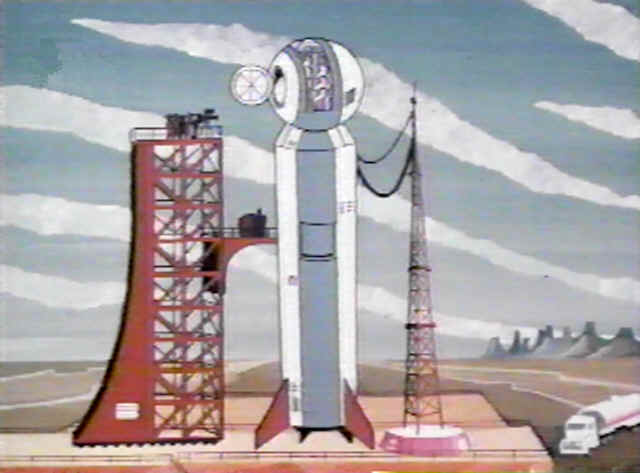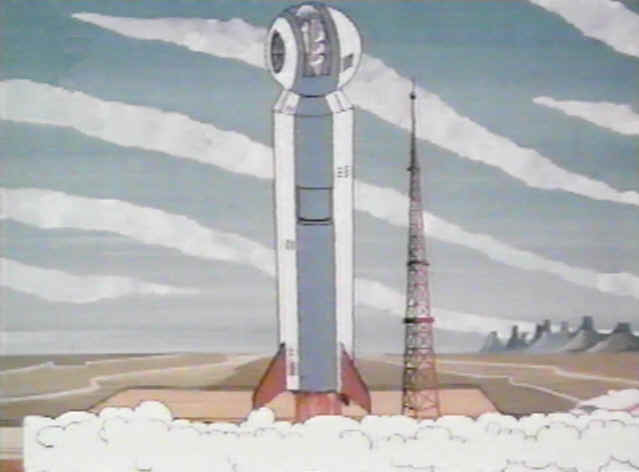

Josie and the Pussycats in Outer Space
Jack Hagerty, LUNAR #002
All images ©Hanna-Barbera
So, you say you want to get into scale modeling of some fictional rocketry subject, but you don’t know where to begin? You aren’t sure if you have what it takes to do a Bonestell Space Ark or the Discovery from 2001, but you’d like to find out? Well, step right up, have we got the rocket for you!
In the early ‘70s there was a big boom in Science Fiction movies (thanks mostly to 2001) and a minor boom in the rather off beat genre of Saturday morning cartoons featuring animated rock bands.
In 1968, tiny Filmation Studios produced a Saturday morning cartoon series based on the popular Bob Montana comic book series Archie and His Friends. They surprised everyone, including themselves, when it turned out to be a big hit in its second season (1969-70), not so much for the comic skits, but for the “dance numbers” placed in between them. The writers took the four main characters, Archie, Jughead, Betty and Veronica (who had never shown any interest in music in the comic books) and placed them in their own rock band. For some reason, watching crudely animated characters gyrate around on the small screen, bereft of plot resonated strongly with the pre-teen audience. The group, called “The Archies,” naturally, even had one reasonably big hit, the bubble-gum rock Sugar-Sugar which can still be heard occasionally on “oldies” rock stations.

Not to be outdone, Saturday morning powerhouse Hanna-Barbera, the studio that invented the whole Saturday morning cartoon genre (whether for good or ill is a matter of personal opinion), fought back with their own teen-band show. They took a different set of teens from another Archie comic book series, called Josie, and turned them into a traveling band as the main plot rather than as a filler between sketches. It was never explained why these kids weren’t in school (which is where the comic book was set).
The band was called Josie and the Pussycats, as was the show, and it premiered on CBS on 9 September 1970. The cast consisted of band leader Josie, a red-headed guitarist; Melody, a blonde drummer who is (how can we put this delicately) a few bricks short of a load, but on the other hand is built like a brick, uh, outhouse. Rounding out the trio is Valerie, a black tambourine player who more than makes up for Melody in being the brains of the outfit. The three girls perform wearing tiger and leopard costumes complete with tails and with cat ears poking out of their hair. Josie was voiced by Janet Waldo for the speaking parts and Cathy Douglas for the singing. Melody was performed by Jackie Joseph speaking and Cherie Moore (short for Cheryl Ann Stopylmore, better known today as Cheryl Ladd) singing. Valerie was spoken by Barbara Pariot and sung by Patrice Holloway.

Also in the cast for dramatic purposes is their hunky, but clean cut, roadie, Alan M (voice by Jerry Dexter); their cowardly, but rich, manager Alex Cabot (voice by Casey Kasem); and Alex’s spoiled rich-kid sister Alexandra (voice by Sherry Alberoni, one of the original Mousketeers). Alexandra is there mostly to drive the plots, such as they are, as both she and Josie have eyes for the hunky Alan M (who’s last name was later revealed by Archie Comics to be “Mayberry”) and it’s her scheming to get him away from Josie that usually gets them into trouble. There’s also a cat named Sebastian voiced by Hanna-Barbera stalwart Don Messick.
After 16 episodes spread over two seasons, the producers of the show decided they had to “punch up” the plot line some, so they shot the whole troupe off into space where they bounced around the planets doing pretty much the same things they did driving around on Earth in the band’s bus. As part of the change they added “in Outer Space” to the title and another character, a non-descript cuddly alien named “Beep” (also voiced by Don Messick). This version also lasted 16 episodes over two years before slipping quietly into syndication.

The show still has a surprisingly loyal following considering it was a (comparatively) short lived, minor entry in the HB pantheon which ended over 25 years ago. There are numerous web sites either wholly or partially devoted to it and the series (both of them) are re-run occasionally on the Cartoon Network. The three actresses that did the singing for the trio even toured together briefly and cut some albums. In early 2000 there was even a rumor of a live action film version in the works.
The Story
The story of how our heroes wound up in outer space (as recounted under the credits of every show) is that the band was invited to play at the launch of a new NASA spaceship (well, a new spaceship, anyway; there are no NASA logos or anything else that would indicate who built it, but there was nobody else in the US building spaceships at the time). They ride to the top of the gantry and pose in front of the open hatch for a photo-op. Alexandra attempts to knock Josie out of the spotlight (literally) with a body slam and they all go tumbling into to the open hatch. In a gravity and orientation challenged sequence worthy of Rocketship X-M, they fall inside, but the close-up shows them falling in toward the control panel at the front of the cabin (meaning that they were falling up since the rocket is standing on its tail). Anyway, as she falls, Alexandra grabs the launch lever and pulls it, sending them off. You don’t have to worry what happened to the photographers still on the gantry (who should have gotten toasted as the ship roared off) because the gantry conveniently disappears for the long shot of the ship taking off.

Naturally, flying something as simple as NASA’s latest-and-greatest is not a problem for Valerie who manages to control the thing by pumping the two big levers that emerge from the floor.

That’s pretty much it. Each episode has them getting into some sort of situation (usually caused by either Alexandra’s jealousy or Melody’s dim nature) which involved the main characters getting chased a lot. Most of the time it’s Valerie’s smarts that get them out of trouble and off to their next adventure.
The Vehicle
There are challenges and then there are challenges. How do you describe a vehicle which the creators themselves can’t seem to agree on?
As mentioned at the beginning, the film 2001 was having a tremendous impact on the popular image of spaceships at the time. We can see by this example that the influence had filtered down to the Saturday morning cartoon level. The ship is quite obviously a caricature of the Discovery from that film. The round crew sphere at the front, with it’s curved “slit” window followed by a conical transition section to a long and comparatively thin propulsion section is unmistakable. Of course, the business end back by the tail was rendered more like a 4th of July skyrocket.

The difficulties in describing it come from the fact that it never seems to be quite the same ship twice. The biggest problem is the fins. In the opening credit sequence (which has the greatest variety of shots) the fins migrate all over the tail end, sometimes looking like four equal fins spaced evenly around in the middle of the blue and white stripes, and sometimes like two pair of closer spaced fins on opposite sides of the body straddling the blue stripe. Sometimes the fins look uneven (a big pair and a little pair) like the von Braun Ferry rocket, but that would be giving it far too much historical credibility.
The fins aren’t the only problem. The big square door on the aft body is usually shown on the starboard side, but it sometimes shows up portside, and occasionally disappears all together! Likewise, the personnel sphere doesn’t sit still on the transition cone. Usually the blue band on the sphere lines up with the blue stripe on the aft body, but sometimes it’s rotated as much as halfway into the white stripe on the body. You could almost convince yourself that the sphere swivels on the cone, but nothing in the stories would indicate this feature.
The accompanying data drawing is a compilation of more hours than we want to admit single framing through the opening sequence to come to a consensus as to what the “average” state of this spaceship is. We think it’s reasonably close to the intentions of the producers and, in fact, treats the subject far more rigorously than they did. On the other hand, we don’t really need to worry too much about rigor in this case. After all, this isn’t rocket science.
[Technical difficulties prevents me from printing the data drawing. -ed]
Quickspec:
Josie’s SpaceshipVehicle Morphology..........Standard
Year ........................................1972
Medium…......................TV Cartoon
Designer..................Hanna-Barbera
Height...............…..........75 ft (23 m)
Diameter (sphere)…...…14 ft (4.4 m)
Diameter (body)......….…12 ft (3.5m)
Modelers’ Note:
Among the fans of this show in its original release is the young boy who grew up to become NAR scale guru Peter Alway; although he admits that he probably couldn’t sit through a whole episode today. In fact, it was Peter who suggested this entry saying that it would make an easy first subject as an introduction to the world of flying scale modeling. OK, Peter suggested it and we burned up the brain cells analyzing it. The rest is up to you folks!